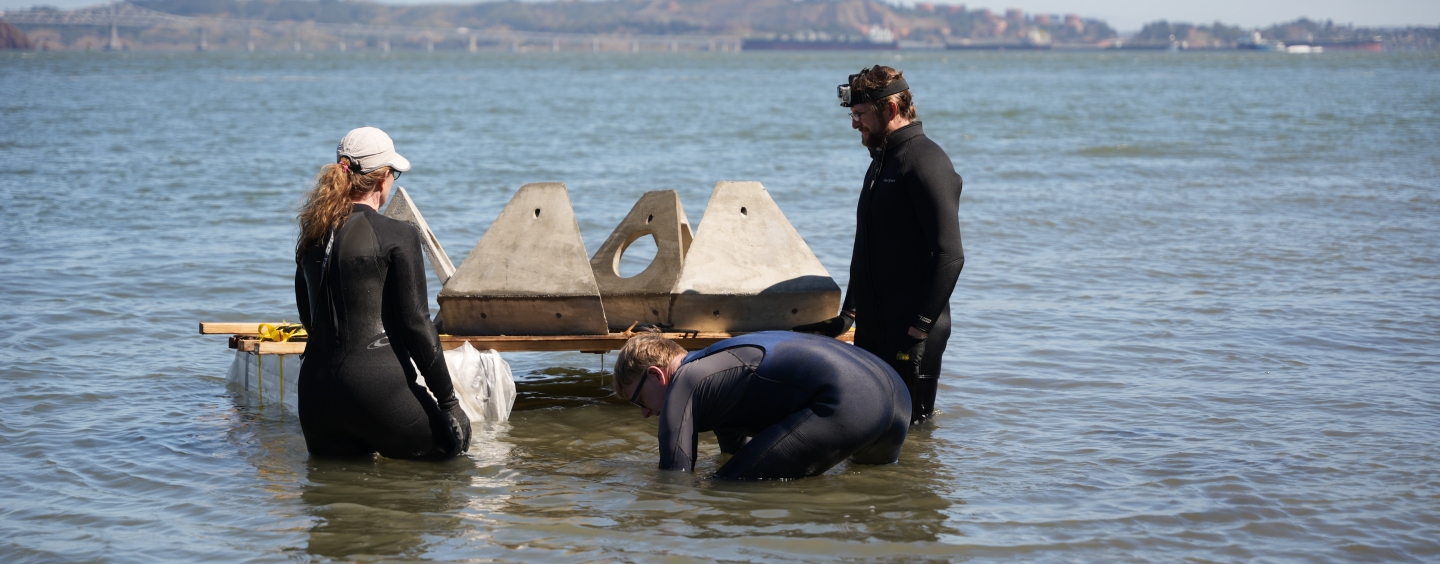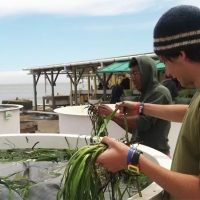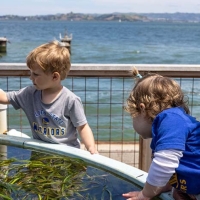EOS Center researchers, community members team up for shoreline restoration

Read the full story on SF State's Strategic Marketing & Communication's website.
A group of San Francisco State University researchers was grateful to have the community get involved in a new project designed to support native plant and animal life in the San Francisco Bay.
“It’s like putting together some Ikea projects,” research fellow Daniel Harris said of the innovative manmade oyster reefs he and his colleagues were prepping for placement in the Bay. “Probably a little bit easier actually than some Ikea flat packs I’ve put together.”
Of course, the San Francisco State scientists — part of a team from the University’s Estuary & Ocean Science (EOS) Center — are more than capable of putting together a complicated project. But the new reef design project gave them an opportunity to not just enlist the community for help but to educate them about EOS and the science behind it.
“Even though people around the Bay live with water all around them, they don’t necessarily know what’s under the water. They are not always aware,” said SF State Professor of Biology and interim EOS Executive Director Katharyn Boyer.
About 15 volunteers answered the call, coming to the EOS Center to assemble molds and pour concrete for the manmade reefs on July 7. According to Boyer, the reefs will support native oysters and other species that need hard surfaces on which to attach and grow. Boyer and her team are also interested in the interactions of these reefs with the submerged aquatic plant, eelgrass, as the latter may grow better when protected by the reefs, with both combating shoreline erosion. The oysters can also impact ecosystem services, such as water filtration of habitats.
In the past, the team used large reef balls made of concrete mixed with sand and shells that weighed about 1,000 pounds. Since the reefs were so heavy, the scientists needed the aid of cranes and machinery to set up the living shoreline experiments. Boyer and Harris wanted to make reefs that are easier to fabricate and work with but are more conducive to community involvement. Collaborating with designer Richard Johnson of Studio for Urban Projects, they came up with a mold of laser-cut plywood. The result: reef elements that only weigh about 65 pounds that, because of their unique design, can be organized into a variety of configurations. That’s what the EOS scientists, volunteers and Johnson (who was on hand to help out, as well) were working on at the July 7 event.
Harris emphasizes that the reefs assembled during the event are part of a pilot project: The EOS team will be monitoring their effectiveness over the next three years. It has been a slow process getting the project up and running, partly because of the pandemic and partly because EOS researchers have to coordinate their work with many other organizations to ensure their experiment are following environmental regulations and not endangering any wildlife. The current pilot-scale effort is a test of the performance of the reef elements and their value as habitat. Once things are optimized, they will install scaled-up experiments that can test the effects on reducing wave energy.
“When we do something that the public can see and we tell them about how it’s being set up as an experiment it’s a real opportunity for us to show them with a concrete example of how you would use science to make a decision,” Boyer said.
Boyer and her team have been working on several such living shoreline projects since 2010. Living shorelines can be any kind of nature-based adaption intended to provide habitat as well as some protection for the shore and sometimes the communities near the shore.
For now, the reefs will be placed in three mudflat locations: by the EOS Center in Tiburon, near San Rafael and at Dunphy Park in Sausalito. Researchers will install nine reef units (of four reef elements each, nested together) in each location, monitoring the organisms attracted to them and how the structures hold up. As they gather data, they plan to set up displays with QR codes that will enable community members to follow along with the project.
“[It’s] making the connection between the vista view and the Bay. It’s not just something that you’re looking at,” Daniel Harris said. “You’re integrated and connected with that place you know. So it’s a living place for everybody, not just humans — for oysters [and other sea life], as well.”
Tags


